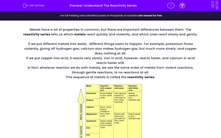Metals have a lot of properties in common, but there are important differences between them. The reactivity series tells us which metals react quickly and violently, and which ones react slowly and gently.
If we put different metals into water, different things seem to happen. For example, potassium fizzes violently, giving off hydrogen gas; calcium also makes hydrogen gas, but much more slowly; and copper does nothing at all.
If we put copper into acid, it reacts very slowly. Iron in acid, however, reacts faster, and calcium in acid reacts faster still.
In fact, whatever reaction we do with metals, we see the same order of metals from violent reactions, through gentle reactions, to no reactions at all.
This sequence of metals is called the reactivity series.
.jpg)
Some people like to use a mnemonic to remember the order.
You could use: Please Stop Calling Me A Zebra I Collect Smart Goats ... but you don't have to!
Displacement reactions and the reactivity series
This picture shows what happens when you put a piece of zinc (a grey metal) into a solution of copper sulfate (a blue solution).

The brown metal forming in the beaker is copper because a chemical reaction has happened:
copper sulfate + zinc → zinc sulfate + copper
Zinc has replaced copper in the compound, leaving the copper to form metal atoms. This kind of reaction is called a displacement reaction because the zinc has displaced (or pushed) the copper from the compound.
The rule linking displacement reactions and the reactivity series is: The more reactive metal goes in the compound, and the less reactive metal stays as a metal.
So if you put aluminium in copper sulfate solution, this reaction happens:
copper sulfate + aluminium → aluminium sulfate + copper (aluminium is more reactive than copper, so it goes into the compound)
If you put iron in magnesium nitrate solution, no reaction happens:
magnesium nitrate + iron → magnesium nitrate + iron (magnesium is more reactive than iron, so it stays in the compound)
By trying lots of reactions like this, and noting which metals can make a reaction happen, we can sort metals into the reactivity series.
The more reactions the metal does, the more reactive it is.
Now it's time for some questions.








